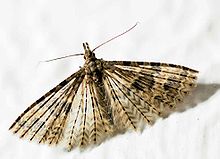Twenty-plume Moth
| Twenty-plume moth | |
|---|---|
 |
|
| Scientific classification | |
| Kingdom: | Animalia |
| Phylum: | Arthropoda |
| Class: | Insecta |
| Order: | Lepidoptera |
| Family: | Alucitidae |
| Genus: | Alucita |
| Species: | A. hexadactyla |
| Binomial name | |
|
Alucita hexadactyla Linnaeus, 1758 |
|
| Synonyms | |
|
|
The twenty-plume moth (Alucita hexadactyla) is a "micromoth" of the many-plumed moth family (Alucitidae). It is found in Europe and has been introduced into North America.
The wingspan is 14–16 mm. Unlike a typical moth, which has two pairs of scaly wings, Alucita has about twenty thin feathery plumes (with scales on the supporting ribs). It perches with the wings outspread like a fan. The wings have a bold zigzag pattern in white, black and brown, which together with the shiny backward-pointing hairs on each plume make the adult moth distinctive.
The moth is also popularly known as the many-plumed moth, while the specific name hexadactyla comes from the Greek for six-fingered.
The moth flies the whole year depending on the location. It is common and often found in gardens, but is readily overlooked because of its small size.
The caterpillar larvae feed on honeysuckle (Lonicera). They are leaf miners, tunnelling inside the leaves of the food plant to avoid predators.
...
Wikipedia
